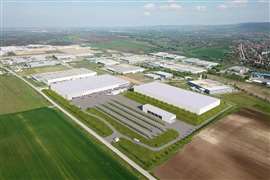Desert bloom
25 April 2008

Despite unrest and difficult conditions in some Middle Eastern countries, the construction industry is booming in the region overall. There is heavy investment in the blossoming tourist industry in countries such as Dubai, including the spectacular Palm Jumeirah resort, which will be visible from outer space.
Even the turbulent situation in some Middle Eastern countries is providing potential for the industry, as there will be plenty of rebuilding and infrastructure work in Iraq and Afghanistan when the current climate cools.
The global oil situation is also driving the crane industry as the region invests to increase production and expand petrochemical infrastructure to meet growing demand, especially from China and India.
In May (see IC news page 6) United Arab Emirates-based Al Jaber Heavy Lift began to take delivery of an order for 40 new crawler cranes from Hitachi Sumitomo in one of the largest orders for new cranes this year. The order included 13 units of the 250 tonne capacity SCX2500-2 and 14 of the 120 tonne capacity SCX1200-2. All 40 cranes will be put to work at gas and oil fields in Qatar. Part of the Al Jaber Group, the Heavy Lift division is headed by general manager Alex Mullins and concentrates mainly on petrochemical and gas related work. “There is an increase compared to previous years,” Mullins says, “but it is a very competitive market because everyone wants to have a go and we are often competing with outsiders.”
Outside influences dictate the nature of Al Jaber's work, as Mullins explains, “It's anybody's guess what happens with the oil fields, it could all come to an abrupt end because of political circumstances such as governments choosing to go with nuclear power.” The potential uncertainty is not a concern for Al Jaber Heavy Lift, however, says Mullins, “Things will go forward. The country needs to become more industrialized and there is an opportunity for steady growth.”
Al Jaber has positioned itself to take full advantage of future developments. It has ordered a new 2,500 capacity Terex-Demag CC 8800 Twin and a new 1,250 tonne capacity Terex-Demag CC 8800 crawler crane. It also operates a fleet of transport modules and Mullins has big plans for that part of the business. “We are aiming to become a door-to-door heavy lifting and transport provider,” he says, “We have started designing and building our own transport modules and we hope to add heavy shipping in the future.”
Parent company Al Jaber operates 8,000 units of heavy construction equipment and is involved in regular projects such as clearing sand dunes to build townships. Mullins says that his heavy lift division is always on hand to assist in these projects.
Finding crane operators is another major issue in the region, especially for large crawler cranes, “We grow our own operators,” says Mullins, “and competitors often try to poach them. We grow them from grass roots and have a real multi-national workforce.”
Al Jaber Heavy Lift was ranked in the IC50 for the first time this year, placed 18th out of 100 companies and Mullins forecasts that the company will improve that position next year with the addition of several big crawlers.
Mullins' concern at the moment is companies from outside the UAE setting up in the region, driving rates down and starting bidding wars. “That,” he says, “would be a bloodbath.”
Waiting for cranes
The topic of crane backlog and delivery times has been well covered and the Middle East is the destination for many new cranes, so how is the situation affecting crane users in the region? “The owners [of Al Jaber Heavy Lift] saw the situation about new cranes a long time ago,” Mullins explains, “They were very quick to spot the upcoming shortage.” He says that there are still cranes available but there is the same wait that the rest of the world is experiencing, “We have to make decisions very early and buy cranes on spec.”
It is not just new cranes that are highly sought after in the Middle East – used machines are also popular. Joe Lyon, managing director of Cranes UK, Tadano Faun dealer in the UK, has noticed the upsurge in interest from Middle Eastern countries. Lyon does not sell new cranes to companies outside the UK but has used trade-in machines that are available to international buyers. “The last three years have seen Middle Eastern customers buy a lot of used cranes,” Lyon says, “mainly Tadano Faun and Kato models from the late 1980s and early 1990s.” The crane buying cycle in Europe now means, Lyon explains, that the next generation of cranes, manufactured in the mid 1990s and after, are being offered as trade ins for new machines. These cranes naturally cost more but are still popular with buyers as the older stock runs out.
Lyon says that around 50% of his company's used crane sales are to customers in the Middle East and Africa.
Sales of new cranes are strong in the region despite the backlogs. Jos Verhulst, sales and marketing manager at Kobelco Crane Sales Europe, claims that the company has sold around 70 new crawlers to the region in the first half of 2006.
New deliveries
Qatar Navigation, a shipping operator based in Qatar, recently bought a 450 tonne capacity Grove GMK7450 wheeled telescopic mobile. The crane was sold to Qatar Navigation by Mannai Trading, Manitowoc Crane Group distributor in Qatar. The GMK7450 is the first of its kind to be purchased in Qatar, MCG says.
Sheikh Hamad bin Suhaim al-Thani, chairman of Qatar Navigation, said all three companies involved in the sale continue to play an important role in Qatar's future. “The construction industry in Qatar is growing, and we appreciate Mannai's service and the quality of Manitowoc Crane Group equipment supplied to us,” al-Thani said.
According to Hamid Summers, Middle East sales manager for Grove, “One of our objectives in the Middle East is to better serve our customers with a local point of contact, and MCG is in the process of establishing a new facility. A total of 32 engineers will be on call, ready to back up our distributors, so that MCG can provide the best service possible.”
By the time of writing in late June, Italian manufacturer Autogru Rigo reported sales of 20 new mobiles into the Middle East in 2006. Export manager Daniele Rigo told IC that Al Jaber has bought six new mobile cranes to be put to work in UAE, Bahrain, Oman, Qatar and Saudi Arabia. The order consisted of two 25 tonne capacity rough terrain RT 200s, one 30 tonne capacity rough terrain RT 350, two 35 tonne capacity rough terrain RT 400s and one 100 tonne capacity all terrain, the RTT 905. Al Jaber operates as Rigo's sales agent and after sales service provider in the Middle East.
Autogru Rigo's recently launched 50 tonne capacity RT 500 rough terrain crane is also proving popular in the region, especially with, Middle East Equipment Trading (M.E.E.T.) which has bought 14 units so far this year, Rigo says.
The tower situation
Forests of tower cranes are a primary feature of the skyline of most major cities in the Middle East. Rumour has it that around 30% of the world's tower cranes are at work in the region.
Making their contribution are five Potain tower cranes, which are being used on the Bahrain City Gardens project, also known as the Bahrain World Trade Center (WTC). The structure rises 240 m above Bahrain's capital, Manàma, and comprises two 50 storey towers joined at several points by 30 m bridges. The cranes arrived on site in February 2005 and were supplied by Abu Dhabi, UAE-based rental firm NFT.
A range from small to large tower cranes are on site. A 16 tonne capacity Potain MC 300-K16 top slewing flat top model with 70 m jib is the largest and tallest crane, erected to a height under hook of 260 m. It was erected to install heavy steel structures on both towers and to dismantle two 8 tonne capacity Potain MC 175 flat tops, each with 40 m jibs and climbed to 200 m.
For the first 200 m of the project, the cranes were placing concrete to stabilise the building and lifting steel elements into place for the final part of the build. The two other tower cranes on the job were used to construct the WTC's podium. For this, a 12 tonne capacity top slewing saddle jib H30/23C model was used at a height under hook of 40 m, in addition to a 12 tonne maximum capacity top slewing saddle jib MD 265 with a jib of 60 m and height under hook of 45 m.
The Bahrain World Trade Center will be one of the tallest buildings in the city and boasts a number of modern features, including three wind turbines, positioned across the 30 m long structures linking the towers, to provide a renewable source of energy for the building. The shape of the towers channels the airflow through the turbines, improving output.
In addition to commercial property, the WTC will include a 256-room hotel and 30,000 m2 of retail outlets and restaurants on the ground floor. It will be visible throughout the small island nation.
Dubai bonanza
More than 60 property developers, including Diamond Investments, Emaar and Nahkeel, are building skyscrapers, condominiums and villas in the Dubai Marina development. Demand is such that crane operators “are in very short supply, they're like gold dust,” according to one contractor.
Progress on many of the high rise buildings has been hampered by materials shortages, including cement, steel and high quality sand to make glass. Materials have been sourced from Europe, the Far East and the rest of the Middle East to cope with the demand. Last year the Government lifted the import duty on cement, capped prices and limited exports in a bid to keep projects on schedule.
Dubai Marina will house 120,000 people in a “high quality” urban development that centres on a 4 km long channel of water, which will be connected to the Arabian Gulf at each end to assist the natural flushing of the system.
Peninsulas at each end of the scheme will provide additional land for development and help to protect the channel from silting up and the effects of wave action. The channel will be built to provide boat moorings for vessels up to 30 m long in the main basins, and up to 20 m long in the central channel. Water taxis will provide transport in the marinas.
In the UAE two contractors, nine towers, 16 twin Alimak hoists and 18 Liebherr cranes, including two 112 HC-L luffing jib models, are working on the Jumeirah Beach Residence (JBR) project Sectors 5 and 6. Al Shafar General Contracting and Al Ahmadiah Trading & Contracting Co are each using eight Liebherrs for the Sectors 5 and 6 contracts of the JBR project.
Al Shafer chose luffing jib cranes, a type used for the second time on a project in Dubai. Both the 112 HC-L luffers have an under hook height of 240 m. According to Al Shafar project manager, Ehab Edward Narouze, the company chose the luffing jibs for Tower ADI due to space restrictions, even though it occupies the biggest area. “It is also very close to the road and the cranes cannot, therefore, swing across the road,” Narouze explains, “It is also close to the adjacent sector.”
Forming part of Sector 6, Al Shafar's contract includes two 44 storey towers and a 26 storey building, linked to a 40 storey one. All four towers and a link building have a four-storey podium and final heights range from 107 to 172 m.



